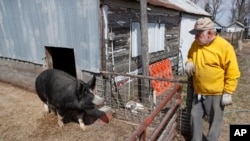At a time when many Americans are growing concerned about the cost and availability of meat items on grocery store shelves, Illinois pork producer Brian Duncan is worried about his farm surviving what he calls an “economic tsunami.”
“The market has fallen off the cliff,” Duncan told VOA. “Hogs on our farm, the price has dropped 50%.”
Duncan somberly admitted he’s hemorrhaging money on each hog he is able to market.
“Every hog that goes to town right now is taking about $60 or $70 of equity with it. It’s the worst I’ve ever seen,” he said.
Contributing to the steep price drop is changing demand, both domestically and internationally, as COVID-19 restrictions shuttered many restaurants, cafeterias and public food venues. While consumer demand for pork is strong, commercial demand has evaporated.
Another major factor is the spread of coronavirus among workers at U.S. meat processing plants, forcing the suspension of some operations and reducing the country’s overall slaughterhouse capacity.
A top U.S. meat processing executive recently warned that America’s food supply chain is breaking. Meanwhile, prices for commodities like hogs and chicken continue to plummet.
“We’re not shutting down every packing plant in the United States. It’s localized, so we’re diverting animals from one facility to another. It’s going to cause disruptions,” explained Karl Setzer, a commodity risk analyst with Agrivisor. Setzer doesn’t foresee a dramatic rebound in hog prices even as processors that closed or suspended operations eventually ramp back up.
“We’re going to see some weaker values as we move forward simply because packers aren’t going to be in a hurry to go out and get animals that they can’t process in a timely manner, that they can’t get through their chutes,” he added.
While it might be harder to find preferred cuts of meat on store shelves, and the cost of what can be purchased from a grocer’s freezer may rise, Setzer says the overall number of hogs in the U.S. actually needs to shrink to stabilize prices.
“We’re going to need a scaling back of production to get through this with the hogs,” he said.
The result is a seeming paradox: supermarkets unable to meet demand for pork even as farmers feel economic pressure to reduce livestock. And hog farmers aren’t the only ones impacted.
“It just depresses our prices,” said Ron Kindred, who isn’t raising hogs on his Atlanta, Illinois, farm but does plan to grow soybeans.
The crops Kindred grows are a source for food products that supply livestock producers with feed for their animals. Fewer hogs mean decreased demand, which affects soybean and corn prices, and ultimately, Kindred’s bottom line.
“We’ve got to have the demand to have support or else the prices just keep dropping and that’s what we’ve seen to this point with this COVID going on in these processing plants cutting back or shutting down. It has a huge impact on us here in the countryside,” Kindred said.
U.S. President Donald Trump’s move to invoke the Defense Production Act to keep meat processors functioning is a sign of hope for farmers like Duncan and Kindred struggling with the worst economic conditions in a generation.
“I think it’s good for us out here on the farm that processing plants stay open,” Kindred told VOA. “I think what they’re worried about is feeding the people here in the U.S. If we shut all of our meat processing plants down and aren’t sending that meat out, then what are people going to eat? We’re going to have a big uproar if people here in the U.S. don’t have cheap meat to eat.”
A dwindling availability of certain types of meat could grow worse as supply chain issues persist from the farm where animals are raised to the dinner table where they are consumed.
“We’re in a new normal now, and the fact of the matter is we don’t know what that looks like,” Setzer said. “We don’t know what the demand is going to be after this, and that’s what’s really weighing on our markets right now.”







